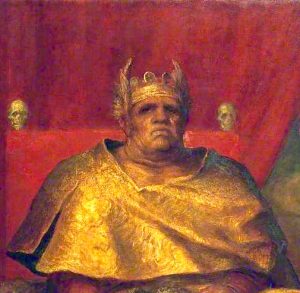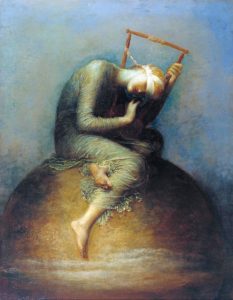
Some people have been asking me about the picture in my last post. It is worth a closer look. Its message is, sadly, timeless, but particularly relevant to our troubled age. In the 1880s, the artist, G. F. Watts (1817–1904), was a senior figure in the London art world and known as ‘England’s Michelangelo’. He was an intellectual whose work pioneered symbolism; a deep thinker who painted ideas. Oscar Wilde called him ‘a great originative and imaginative genius’.1 Barak Obama was particularly drawn to Watt’s Hope which, I read somewhere, hung in the White House, and Watts was an inspiration to Martin Luther King. (This Guardian article is a good introduction to Watts.)
The full title of this work is Mammon—dedicated to his worshippers and the heavy, gilded, obscene demonic deity dominating this image is ‘massive’, that is, weighed down by gold whose gravitational pull binds him to the earth. His gouty leg (more visible in the artist’s line drawing of the subject) and unfeeling, swollen arm bear down on lifeless figures—fragile humanity, the imago Dei crushed by the weight of unfeeling avarice.
Mammon’s sensibility, like many current world leaders and kleptocrats, is anaesthetised by gold. He seems oblivious to those he is destroying. Likewise his heavy-lidded, dark eyes, though ostensibly staring into the distance, seem blind. He is preoccupied by gold; his gaze is turned inwards as he meditates on wealth. It is a gaze reminiscent of Milton’s Mammon in Paradise Lost—one looking downwards, fixated by the golden pavements of heaven rather than lifted towards God. In other words, he is the antithesis of true worship:
Mammon, the least erected Spirit that fell | From Heaven, for even in Heaven his looks and thoughts | Were always downwards bent, admiring more | The riches of heaven’s pavement, trodden | gold, than aught divine or holy else enjoyed | In vision beatific.2

We have a tendency to look with smug superiority at our ancestors such as the Victorians, thinking of them as another race lost in the mists of history and ourselves as being enlightened. But this picture offers a salutary warning. We are ‘Victorian’. We are making exactly the same mistakes.
After the many social challenges of the early nineteenth century such as numbing industrialisation, Asiatic cholera, and the Irish famine, Watts was painting at a time of growing optimism—an optimism he did not share. Like writers such as John Ruskin, Thomas Carlyle, and Herbert Spencer, he despaired at the injustice wrought by unchecked capitalism that had, in Ruskin’s words, used humans ‘like fuel to feed the factory smoke’,3 where children as young as twelve worked fourteen hours a day in the factories. In my old hometown of Bolton, in England’s northern industrial heartland, many did not live beyond their teenage years. Such conditions, forty years before this image was painted, led Karl Marx to pen The Condition of the Working Class in England (first published in 1845 in German) and Engels The Condition of England (1844). The foundations of communism were laid with the factories in Manchester.
Our age is also stained by avarice; an age of corporate and individual greed; a world where the disparity between rich and poor is equally, if not more, obscene—and growing. For example,
The billionaires who make up the Forbes 400 list of richest Americans now have as much wealth as all African-American households, plus one-third of America’s Latino population, combined. In other words, just 400 extremely wealthy individuals have as much wealth as 16 million African-American households and 5 million Latino households.
Even more sobering was the recent Oxfam report pointing out that eight individuals own the same wealth as half the world’s population; eight people, in effect, have power over 3.6 billion people who make up the poorest half of humanity, of whom, 360 million are surviving on less that $2 a day.
From a theological perspective, the darker issue is Christianity’s alliance with evil, particularly—as discussed in my last post—Mammon. There, I used the word ‘hallucinogenic’ to describe Southern Baptist Pastor Robert Jeffress’s assessment of Trump as a President who ‘wants to make America good again’. (Jeffress, by the way, is worth around $15 million or so and doing very nicely, thank you.) He is merely repeating history—a delusional blindness that also characterised certain Christian assessments and responses to social issues in Victorian times. Let me explain.
Broadly speaking, in the nineteenth century, British nonconformity (that is, those rejecting the State Church) was having its time in the sun. Increasing nonconformist wealth and political clout led to optimism that the true church (as opposed to those corrupt Anglicans in league with the establishment) would take up its rightful, God-ordained role as the moral guide of society. This, in a society intoxicated by the concept of evolutionary progress leading to the equally hallucinogenic view that society was evolving morally despite blatant evidence to the contrary. Furthermore, there was growing optimism—perhaps reinforced by global imperial conquests—that such moral evolution was preparing the way for a golden age under the rule of King Jesus. Millennial fever—a focus on eschatology (the end times)—inevitably grows when humans fail to rightly assess what is under their noses.4 Climate change denial, for example, is endemic among American Evangelicals. In present day America, as in Victorian Britain, an increasingly proud minority of Evangelical Christians, confident in their moral superiority, feel it is their duty to impose their defective morality and delusional world view on their fellow-citizens.
The main point here is this: I regularly meet Christians delighted that prayer is going on in the White House, or who say things like, ‘Well, at least prayer is going on—that’s a good thing!’ But there are two problems. First—and this is a core biblical message—that prayers can be offered to idols, ‘foreign gods’. Prayers can be aimed in the wrong direction. Second, that there is little point in praying for God’s blessing if one is a champion of inequality and injustice. As Isaiah says (Isa. 1.15):
When you lift up your hands in prayer, I will not look. Though you offer many prayers, I will not listen, for your hands are covered with the blood of innocent victims.
The hands of American Christians are covered in blood.5 Furthermore, American Christianity, as we have seen, is in love with Mammon. Should we not take seriously Christ’s view that you cannot serve two master—God and Mammon (Mt. 6.24)?
G. F. Watts saw through this charade and his picture is a strong protest against a society—a ‘Christian’ society—bowing down to Mammon, violently oppressing the poor, and defacing the imago Dei—fellow humans made in God’s image. Within just a few decades decades of its painting, Europe was to witness the death of around 100 million people as a result of such misguided worship. Will we ever learn the lessons of history?
Notes and references
- Bills, M. and Bryant, B. (eds), G. F. Watts: Victorian Visionary (New Haven and London: Yale University Press/Watts Gallery Compton, 2008).
- Paradise Lost, Book I, lines 679–683.
- The Stones of Venice, 6.14.
- See, for example, David W. Bebbington, The Dominance of Evangelicalism (Leicester: IVP, 2005), pp. 130–132.
- Andrews, Dave, The Jihad of Jesus (Eugene, OR: Wipf & Stock, 2015).
